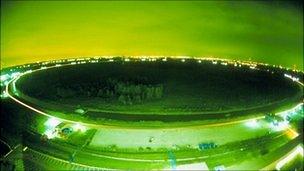Higgs boson 'hints' also seen by US lab
- Published

The Tevatron might also be seeing hints of the elusive particle
A US particle machine has seen possible hints of the Higgs boson, it has emerged, after reports this week of similar glimpses at Europe's Large Hadron Collider (LHC) laboratory.
The Higgs boson sub-atomic particle is a missing cornerstone in the accepted theory of particle physics.
Researchers have been analysing data from the Tevatron machine near Chicago.
The hints seen at the Tevatron are weaker than those reported at the LHC, but occur in the same "search region".
Physicists have cautioned that these possible hints could disappear after further analysis.
But researchers also say when the US and European results are taken together, they start to paint an "intriguing" picture.
The results are being presented and discussed at the Europhysics conference in Grenoble, France.
The Tevatron and LHC machines work on similar basic principles, accelerating beams of particles to high energies around a tunnel before smashing them together.
These collisions can generate new particles which can then be picked up by detectors built at the points where particle beams cross over.
The LHC, which is housed in a 27km-long circular tunnel below the French-Swiss border, has two detectors looking for the Higgs: Atlas and CMS. Each is staffed by a different team of scientists.
The Tevatron has a comparable arrangement, with two detectors called DZero and CDF.
Just a quirk?
On Friday, the Atlas and CMS teams reported finding what physicists call an "excess" of interesting particle events at a mass of between 140 and 145 gigaelectronvolts (GeV).
The excess seen by the Atlas team has reached a 2.8 sigma level of certainty. A three-sigma result means there is roughly a one in 1,000 chance that the result is attributable to some statistical quirk in the data.
Now, the US DZero and CDF experiments have also seen hints of something at about 140GeV.
Professor Stefan Soldner-Rembold, spokesperson for the DZero detector team, told 91热爆 News: "There are some intriguing things going on around a mass of 140GeV.
The Atlas experiment is one of two multi-purpose experiments at the LHC
Professor Soldner-Rembold, from the University of Manchester in the UK, added: "There might be some picture emerging from the fog."
The Tevatron is also seeing the same type of interesting particle events as the LHC. In these events, one elementary particle "decays", or transforms, into another with a smaller mass.
The interesting fluctuations seen at the Tevatron and the LHC are dominated by what might be the Higgs decaying into a pair of "W boson" particles.
But the Tevatron results are currently at the one-sigma level of certainty - a lower level of statistical significance than those presented by the Atlas and CMS teams.
Five-sigma is the level of certainty generally required for a formal discovery. At this significance level there is about a one in 1,000,000 chance that a bump in the data is just a fluke.
However, says Professor Soldner-Rembold, the fact that teams working independently are now seeing similar phenomena point to an exciting possibility.
The existence of the Higgs boson was first proposed in the 1960s by Edinburgh University physicist Peter Higgs. The boson helps confer the property of mass on all other particles through their interaction with something called the Higgs field.
The efforts put into finding the boson relate to its status as the last missing piece in the the Standard Model - the most widely accepted theory of particle physics.
The Standard Model is a framework that explains how the known sub-atomic particles interact with each other. If the Higgs boson is not found, physicists would have to find some other mechanism to explain where particles get their mass.
- Published23 July 2011
- Published1 July 2011
- Published17 June 2011
- Published15 June 2011
- Published26 April 2011
- Published28 February 2011